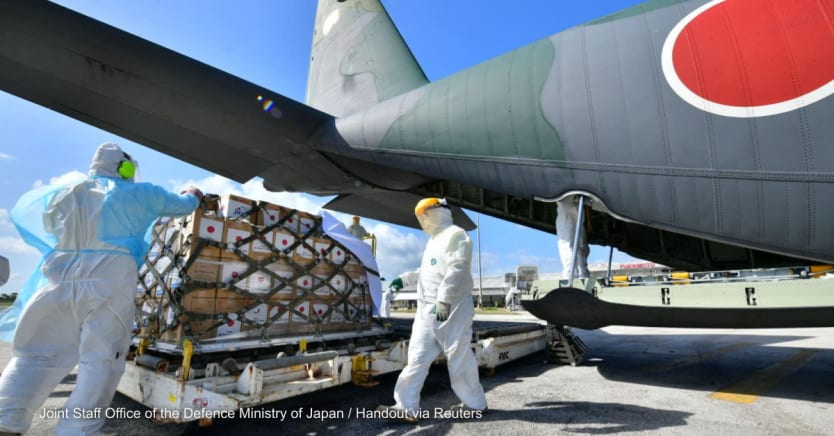
As Tonga struggles to recover from the Jan. 15 volcanic eruption that caused a tsunami, which has so far claimed three lives, the response effort risks bringing an additional health challenge to the already fragile country. Tonga has only recorded one case of COVID-19 according to the World Health Organization — and aid workers want to keep it that way.
The must-read weekly newsletter for exclusive global health news and insider insights.
“Tonga does not need a COVID disaster on top of the impacts of the eruption and tsunami,” Sophie Ford, response manager for international programs at the Australian Red Cross, explained to Devex.
“It would potentially devastate the community of 107,000 people and overwhelm the health system. All organizations providing external response support must work to maintain the safety of the community.”
Despite the threat of further eruptions now reduced significantly, the response and recovery is slow-going hampered first by volcanic ash limiting support and lack of communications due the severing of the nation’s single undersea fiber-optic cable.
“It is very evident that the investment to strengthen the core capability of local organizations is paying dividends.”
— Sophie Ford, response manager for international programs, Australian Red CrossThe impact on agriculture and marine sectors were still yet to be assessed as part of the clean up while the focus remained on supporting those most severely affected by the disaster. “We never expected that such a disaster would put us in this very, very difficult situation,” Sione Hufanga, U.N. coordinator in Tonga, explained in an interview on Jan. 21.
Water, food, sanitation, hygiene, and rebuilding of schools were among priorities, Hufanga said, which were “beyond the resource boundary of the country.”
The Tongan government has requested contact-free aid — and humanitarian organizations have the dual challenge of ensuring that COVID-19 is not imported into the country inadvertently, and that the local partners on the ground are supported enough to ensure a quick recovery from the disaster.
The response and the risks
The proximity of Australia and New Zealand to Tonga has meant that these countries are essential in providing the supplies needed — and quickly. It took five days for ash to be cleared from airport runways enabling the first supply plane to land, a New Zealand air force plane. It brought water containers, temporary shelters, generators, hygiene and family kits, and communications equipment. Supplies from Australia followed, as well as Japan, with the United Kingdom also announcing support.
The EU is also planning the delivery of supplies in collaboration with France.
The government of Tonga has established a process requiring contactless delivery of supplies. The first New Zealand flight was required to leave supplies on the tarmac, and was on the ground for just 90 minutes to reduce the risk of COVID-19 spreading to the community. Testing of crews on planes and ships is also essential to detect and prevent COVID-19.
This, however, is proving to be a greater challenge than anticipated as little over two million new cases of COVID-19 have been confirmed in Australia over the past 28 days according to Johns Hopkins University, along with 1,166 deaths. Meanwhile, New Zealand is implementing new restrictions to prevent further spread of an outbreak in the country.
Tonga has been required to turn one plane around after a COVID-19 case was confirmed aboard, and a ship ready to deliver supplies has been left at sea after 23 confirmed COVID-19 cases. Support from Japan's Self-Defense Force, stationed in Australia, has also been impacted by Australia’s latest outbreak.
“Ultimately, we're in the hands of the Tongan government,” Australian defense minister, Peter Dutton, told the media on Jan. 25. ”We're working very closely with them and they have a 21-day quarantine period. So our ship will either stand off or it can port [and] offload the equipment that's there. We can do that in a contactless way, spray the equipment so that the chance of passing on the virus is obviously negligible.”
“Under no circumstance will we compromise the health and well-being of those Tongans who have already had a concerted effort against … the virus by protecting themselves and the virus is not present on the island.”
Other health concerns
Added to the risk of COVID-19, exposure to air pollution after a volcanic eruption may also put people at risk of acute and chronic respiratory diseases and access to safe drinking water remains a concern, a WHO spokesperson said over email.
“There are reports of water reservoirs being contaminated and in the main island of Ha’apai, groundwater has been contaminated with saltwater. There may be a risk of water-borne diseases such as diarrhea if people drink from contaminated water sources,” the spokesperson said.
Preventing the spread of infectious diseases will also be necessary going forward, by supporting access to clean water and sanitation, and by keeping a close watch for any outbreaks, the global health body said.
On the ground, local matters
The contactless approach to foreign assistance means local civil society is an important partner in delivering support and supplies to those most in need. For NGOs supporting the Tongan response, partnerships with organizations on the ground is essential to ensure the situation is not made worse.
Despite challenges with communication networks, Australian Red Cross’ Ford said the response was working well. “Local partners coordinated by the Tongan Government have demonstrated since the disaster their ability to coordinate effectively and respond immediately.”
For many aid organizations, the disaster will be a test of how well a model refined over the past two years to support localization and empower local leaders, with remote technical support provided as needed works in action.
“It is very evident that the investment to strengthen the core capability of local organizations is paying dividends,” Ford said. “Tongan Red Cross is one of the national societies that we support as part of a five-year DFAT [Department of Foreign Affairs and Trade] and Australian Red Cross partnership putting into practice principles of localization.”
Training and support to undertake risk assessments and scenario planning, running simulations to test response systems and processes, and prepositioning relief stocks for 1,200 households was part of the disaster preparation work that happened in Tonga. With the local networks established, emerging needs will continue to be identified, communicated, and responded to.
WHO had also been working to support the government’s emergency preparedness, including through the training and establishment of the Tonga Emergency Medical Assistance Team, or TEMAT, Tonga’s national EMT, the spokesperson said. “The TEMAT team deployed early in the response to provide critical care to people in the severely affected [the Ha'apai] island group and a small team remains on Nomuka to this day,” they added.
As recovery continues, thoughts turn to long-term support
The full impact of the eruption and tsunami on Tonga is yet to be fully realized, but financial support is trickling in. The Asian Development Bank has approved a $10 million grant to the government of Tonga; New Zealand has announced support of 3 million New Zealand dollars ($2 million); Australia has announced 3 million Australian dollars ($2.15 million) in financial support; the U.K. is releasing £345,000 ($462,327), while $200,000 is being provided by South Korea; €200,000 ($226,000) in initial emergency humanitarian aid funding from the EU; and $100,000 from the United States.
Amruta Byatnal contributed reporting.



